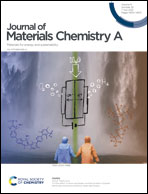Plasmonic gold nanocrystals simulated efficient photocatalytic nitrogen fixation over Mo doped W18O49 nanowires†
Abstract
Photocatalytic nitrogen fixation is a desirable approach to future sustainable nitrogen conversion and might be considered as a potential alternative to the traditional Haber–Bosch process. However, the activation of nitrogen molecules and the complicated nitrogen fixation reaction process have remained grand challenges. Herein, we report an efficient photocatalyst, which was constructed by anchoring plasmonic gold nanocrystals on Mo doped W18O49 nanowires (denoted as Au-MWO). In addition to Mo doping improving N2 adsorption and activation, the anchored Au nanocrystals not only extend light absorption to generate energetic electrons, but also decrease the desorption energy of the NH3, which facilitates the release of active sites and further improves the catalytic reaction of nitrogen fixation. Due to the synergistic effect of Mo doping and Au nanocrystal loading, the plasmonic Au-MWO shows an apparent quantum efficiency of 0.611% at 540 nm and a high ammonia synthesis rate of 399.24 μmol g−1 h−1. This work offers a promising alternative route for designing efficient catalysts and brings fresh insights into the role of plasmonic noble metals in photocatalysts toward nitrogen fixation.



 Please wait while we load your content...
Please wait while we load your content...